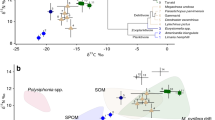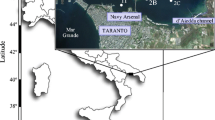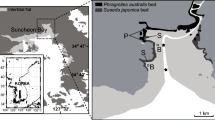Abstract
Swarms of Dioithona oculata, shoals of Mysidium columbiae, and schools of planktivorous fish were observed among mangrove prop roots on a lagoonal island. Detritus covering epiphytic and benthic macroalgae and invertebrates was a probable food source for pelagic mysids, and copepods, as well as benthic oysters and sponges. Open water blooms of dinoflagellate Amphidinium klebsii were probably only accessible to the swarming dioithonans which spend the night away from the mangrove prop roots. Dominant species were analyzed for stable carbon isotopic composition (expressed as δ13C%.) to elucidate the origin and fate of detritus. Detrital components (−23.6 to −19.1%.), which included floating detritus, marine snow, prop root detritus, and detritus below prop roots, probably originated from the dominant subtidal macroalgal species (−24.2 to −14.6%.) and A. klebsii (−25.8 to −21.2%.), although other sources which are end-members could theoretically contribute since detrital isotopic ratios are half way between end-members. These other sources include the intertidal red algal Bostrychia spp. (−30.9 to −29.6%.), red mangrove Rhizophora mangle leaves (−28.2 to −27.0%.), and turtle grass Thalassia testudinum (−12.3 to −11.1%.). Particle feeders such as mangrove oysters, sponges, mysids, and dioithonans were usually enriched with 13C (−21.0 to −16.2%.) compared to their probable food sources, detritus and A. klebsii. At Anchovy Bay, adult mysids and planktivorous fish were more 13C enriched (1–3%.) than their probable prey, the dioithonans. Turtle grass may have a minor role in food webs, since dioithonans and mysids from Outer Twin and Anchovy Bays where turtle grass beds were abundant were consistently more 13C enriched (2–7%.) than in the Lair Channel where turtle grass beds were sparse.
Similar content being viewed by others
References
Ambler, J. W., 1986. Effect of food quantity and quality on egg production of Acartia tonsa Dana from East Lagoon, Galveston, Texas. Estuar. coast. shelf Sci. 23: 183–196.
Ambler, J. W., F. D. Ferrari & J. A. Fornshell, 1991. Population structure and swarm formation of the cyclopoid copepod Dioithona oculata near mangrove cays. J. Plankton Res. 13: 1257–1272.
Benedict, C. R., W. W. L. Wong & J. H. H. Wong, 1980. Fractionation of the stable isotopes of inorganic carbon by seagrasses. Plant. Physiol. 65: 512–517.
Descolas-Gros, C. & M. Fontugne, 1990. Stable carbon isotope fractionation by marine phytoplankton during photosynthesis. Plant Cell Envir. 13: 207–218.
Faust, M. A., 1990. Cysts of Prorocentrum marinum (Dinophyceae) in floating detritus at Twin Cays, Belize mangrove habitats. In E. Granéli, B. Sundstrom, L. Edler & D. M. Anderson (eds), Toxic Marine Phytoplankton. Elsevier Sci. Pub. Co. Inc., Lond.: 138–143.
Faust, M. A., 1992. Observations on the morphology and sexual reproduction of Coolia monotis (Dinophyceae). J. Phycol. 28: 94–104.
Faust, M. A., 1993. Sexuality in a toxic dinoflagellate, Prorocentrum lima. In T.J. Smayda & Y. Shimizu (eds), Toxic Phytoplankton Blooms in the Sea. Elsevier Science Pub. B.V., New York: 121–126.
Fry, B., 1980. Natural stable carbon isotope tag traces Texas shrimp migrations. Fish. Bull. 79: 337–345.
Fry, B., 1984. 13C/12C ratios and the trophic importance of algae in Florida Syringodium filiforme seagrass meadows. Mar. Biol. 79: 11–19.
Fry, B. & E. B. Sherr, 1984. δ13C measurements as indicators of carbon flow in marine and freshwater ecosystems. Contrib. mar. Sci. 27: 13–47.
Gearing, J. N., 1988. The use of stable isotope ratios for tracing the nearshore-offshore exchange of organic matter. In B. O. Jansson (ed.), Coastal-Offshore Ecosystem Interactions. Springer-Verlag, Berlin: 69–101.
Gleason, D. F. & G. M. Wellington, 1988. Food resources of postlarval brown shrimp (Penaeus aztecus) in a Texas salt marsh. Mar. Biol. 97: 329–337.
Heinle, D. R. & D. A. Flemer, 1975. Carbon requirements of a population of the estuarine copepod Eurytemora affinis. Mar. Biol. 31: 235–247.
Herndl, G. J., 1991. Microbial biomass dynamics along atrophic gradient at the Atlantic barrier reef off Belize (Central America). P.S.Z.N.I: Mar. Ecol. 12: 41–51.
Hobson, E. S., 1972. Activity of Hawaiian reef fishes during the evening and morning transitions between daylight and darkness. Fish. Bull. 70: 715–740.
Kleppel, G. S. & R. E. Pieper, 1984. Phytoplankton pigments in the gut contents of planktonic copepods from coastal waters off southern California. Mar. Biol. 78: 193–198.
McIvor, C. C., 1991. Use of multiple stable isotopes to analyze the food web of a mangrove-dominated estuary. Bull. Ecol. Soc. 72: 188.
Modlin, R. F., 1990. Observations on the aggregative behavior of Mysidium columbiae, the mangrove mysid. P.S.Z.N.I: Mar. Ecol. 11: 263–275.
Modlin, R. F., 1993. Population parameters, life cycle, and feeding of Mysidium columbine (Zimmer) in the waters surrounding a Belizian mangrove cay. P.S.Z.N.I: Mar. Ecol. 14: 23–34.
Odum, W. E. & E. J. Heald, 1975. The detritus-based food web of an estuarine mangrove community. In L.E. Cronin (ed), Estuarine Research. Vol. 1. Chemistry, Biology, and the Estuarine System. Academic Press, New York: 265–286.
Peterson, B. J., R. W. Howarth & R. H. Garritt, 1985. Multiple stable isotopes used to trace the flow of organic matter in estuarine food webs. Science 227: 1361–1363.
Rodelli, M. R., J. N. Gearing, P. J. Gearing, N. Marshall & A. Sasekumar, 1984. Stable isotope ratio as a tracer of mangrove carbon in Malaysian ecosystems. Oecologia 61: 326–333.
Rützler, K. & C. Feller, 1988. Mangrove swamp communities. Oceanus 30: 16–24.
Stephenson, R. L., F. C. Tan & K. H. Mann, 1986. Use of stable carbon isotope ratios to compare plant material and potential consumers in a seagrass bed and a kelp bed in Nova Scotia, Canada. Mar. Ecol. Prog. Ser. 30: 1–7.
Turner, J. T. & J. G. Ferrante, 1979. Zooplankton fecal pellets in aquatic ecosystems. Bioscience 29: 670–677.
Zieman, J. C., S. A. Macko & A. L. Mills, 1984. Role of seagrasses and mangroves in estuarine foods webs: temporal and spatial changes in stable isotope composition and amino acid content during decomposition. Bull. Mar. Sci. 35: 380–392.
Author information
Authors and Affiliations
Rights and permissions
About this article
Cite this article
Ambler, J.W., Alcala-Herrera, J. & Burke, R. Trophic roles of particle feeders and detritus in a mangrove island prop root ecosystem. Hydrobiologia 292, 437–446 (1994). https://doi.org/10.1007/BF00229970
Issue Date:
DOI: https://doi.org/10.1007/BF00229970




